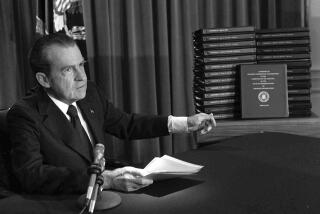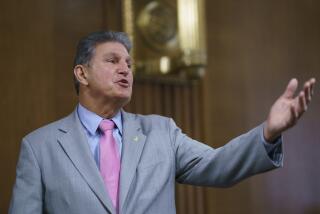A Flexible Freeze to Squeeze the Deficit
- Share via
George Bush describes his plan for shrinking the federal deficit as a flexible freeze. What exactly does that phrase mean? And does it represent a plan that can really work?
The flexible freeze is a specific plan for limiting the growth of government spending. The basic concept is that total federal spending should not grow faster than inflation until government spending and revenue are brought back into balance. Tax revenues increase in a growing economy even when there are no increases in tax rates and no new taxes. So as long as the economy continues to grow, a freeze on the inflation-adjusted level of spending would eventually eliminate the deficit.
The difficulty of using a freeze plan to deal with the deficit is political rather than economic. The Bush plan recognizes that an across-the-board freeze on all spending programs would be politically impossible. That’s why the plan includes flexibility, or the option for some programs to grow more rapidly than others as long as total spending just keeps pace with inflation. The flexible freeze, then, balances faster growth of spending in some areas with slower growth in others.
Bush has said that, as President, he would meet with leaders of Congress to negotiate the details of a multi-year program of deficit reduction, based on his proposal for a flexible freeze. He would come to the negotiations committed to certain principles: Social Security benefits would not be reduced; he would separate defense and nondefense spending, and he would apply the flexible freeze separately to each of these areas. Within this framework, the representatives of the Administration and Congress would negotiate the specifics.
The mechanism already exists for ensuring deficit reduction, but it would need to be tightened as the flexible freeze plan is introduced. The Gramm-Rudman procedure, passed first in 1985, has already succeeded in imposing some budgetary discipline. It calls for automatic annual spending reductions in a wide range of programs when the Congress and Administration cannot otherwise agree on sufficient cuts in the deficit. The goal of this legislation has been to achieve budget balance by 1993.
Despite initial widespread skepticism, this bill has to be judged a success. The deficit has shrunk from $212 billion in 1985 to $155 billion this fiscal year. The reduction has been the result of continued economic growth, spending discipline, tax increases and lower interest rates.
It is notable that when Gramm-Rudman was passed, there was a strong favorable reaction in the financial markets. The likelihood that the Treasury would have significantly lower borrowing requirements as the deficit was reduced contributed to the decline in Treasury bond interest rates from 11.5% in early 1985 to 7.5% in mid-1986.
A mandate to carry out a flexible freeze over the next four years would have a similar favorable effect on the level of interest rates. If interest rates were to fall by another 2%--not an unreasonable assumption given their present high level and the Gramm-Rudman experience--that would reduce by $55 billion the interest outlays on the deficit expected in 1993. But even without a lowering of interest rates, the flexible freeze is a workable proposal for shrinking the federal deficit.
Difficult choices do lie ahead, and cooperation between Congress and the Administration will be essential. If George Bush is elected President, the flexible freeze will provide the starting point for such a cooperative solution to our critical deficit problem.
More to Read
Get the L.A. Times Politics newsletter
Deeply reported insights into legislation, politics and policy from Sacramento, Washington and beyond. In your inbox twice per week.
You may occasionally receive promotional content from the Los Angeles Times.









